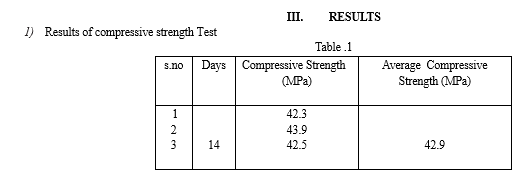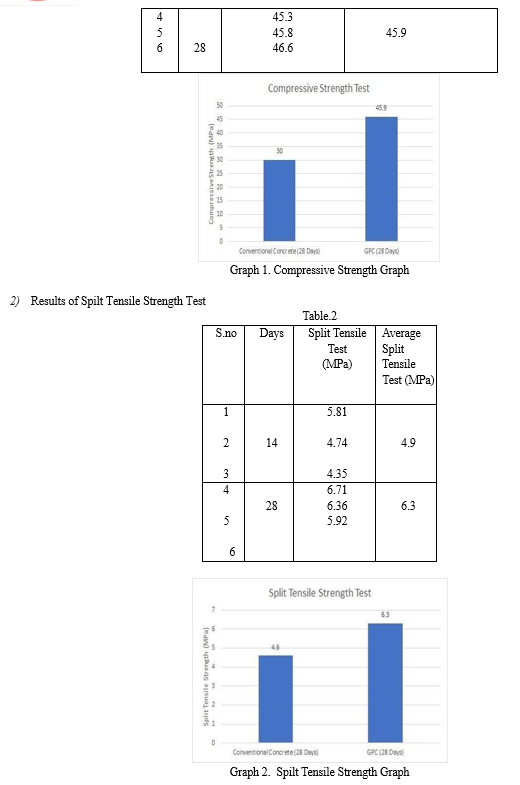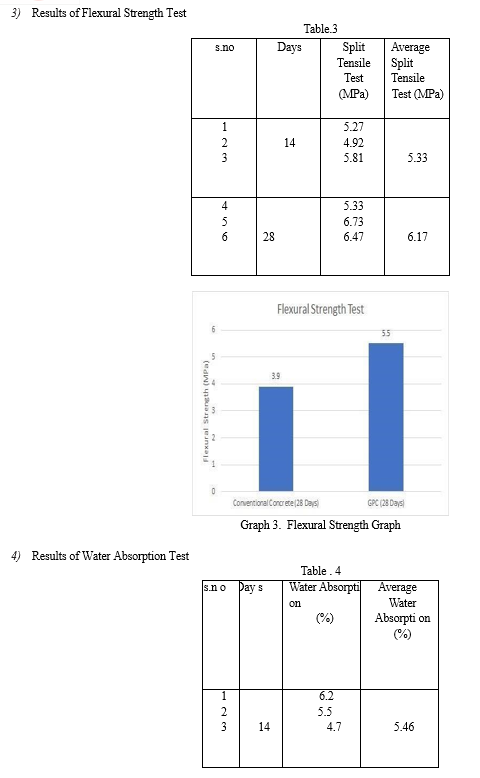Ijraset Journal For Research in Applied Science and Engineering Technology
- Home / Ijraset
- On This Page
- Abstract
- Introduction
- Conclusion
- References
- Copyright
Experimental Investigation on Mechanical and Durability Properties of Geopolymer Concrete
Authors: Dr. A Krishna Rao, M. Yashwanth, CH. Karthik, M. Abhijith, E. Pranay
DOI Link: https://doi.org/10.22214/ijraset.2024.60662
Certificate: View Certificate
Abstract
Geopolymer concrete (GPC) is a new type of concrete that is made with alkaline activators and aluminosilicate materials, such as fly ash and ground granulated blast furnace slag (GGBS). GPC has several advantages over traditional Portland cement concrete (OPC), including higher early strength, better durability, and lower environmental impact. This paper presents an experimental analysis of the mechanical and durability properties of GPC. The mechanical properties investigated include compressive strength, splitting tensile strength, flexural strength, and modulus of elasticity. The results show that GPC has comparable or better mechanical properties than OPC at all ages. GPC also has superior durability properties to OPC, with lower water absorption, higher acid resistance, and lower chloride permeability. The overall findings of this study indicate that GPC is a promising alternative to OPC for a wide range of applications. Since Geopolymer concrete doesn’t use any cement, the production of cement shall be reduced and hence the pollution of atmosphere by the emission of carbon dioxide shall also be minimized. Cement, being a key material of concrete, experiencing a rise in global demand. It has a massive carbon footprint having a contribution of about 8% to the global Carbon dioxide emissions. Geopolymer concrete has a huge potential to replace ordinary Portland concrete. For sustainable construction, GPC reduces the use of cement and finds the alternative of cement for the material\'s binding property. So, the geopolymer concrete is an alternative to Portland cement concrete and it is a potential material having large commercial value and for sustainable development in Indian construction industries.
Introduction
I. INTRODUCTION
Geopolymer concrete is a promising alternative to traditional Portland cement concrete, offering environmental and performance benefits. This type of concrete utilizes fly ash, ground granulated blast furnace slag (GGBS), or other pozzolanic materials activated by alkaline solutions to form a strong and durable binder and reducing carbon emissions associated with cement production. Concrete is widely used in construction due to its formability, raw material availability, and affordability. The investigation focuses on the use of fly ash, GGBS, sodium silicate (Na2SiO3), and sodium hydroxide (NaOH) as the primary components. The investigation aims to determine the range of mechanical properties and durability properties achievable with geopolymer concrete using the chosen mix design and testing procedures. Geopolymer concrete is a promising development in the construction industry, offering a more sustainable and potentially superior alternative to traditional Portland cement concrete. Unlike ordinary Portland cement (OPC) concrete, geopolymer concrete utilizes fly ash, ground granulated blast furnace slag (GGBS), or other pozzolanic materials as the main binder. These are industrial byproducts or waste materials, promoting resource efficiency. An alkaline activator solution, typically a combination of sodium silicate (Na2SiO3) and sodium hydroxide (NaOH), activates the pozzolans, leading to the formation of a strong and durable geopolymer binder. The activation process triggers a geopolymerization reaction. This chemical reaction forms a three-dimensional network of inorganic polymers, binding the aggregates (sand, gravel) within the concrete matrix. Geopolymer concrete production generally has a lower carbon footprint compared to OPC concrete. This is because the geopolymerization process requires less energy and avoids the high CO2 emissions associated with clinker production in OPC .By incorporating fly ash and GGBS, geopolymer concrete provides a valuable outlet for utilizing these industrial byproducts, promoting resource conservation and reducing reliance on landfills. Studies suggest that geopolymer concrete can exhibit good resistance to chemical attack, fire, and wear, potentially leading to enhanced durability in aggressive environments. Geopolymer concrete can achieve compressive strengths comparable to or even exceeding those of OPC concrete, depending on the mix design and curing conditions. Geopolymer concrete is a relatively new technology compared to OPC, and ongoing research is focused on optimizing mix designs, understanding long-term performance, and establishing wider acceptance in construction practices. While offering environmental and potential performance benefits, geopolymer concrete might have a higher initial cost compared to traditional concrete in some regions.
However, as the technology matures and production scales up, the costs are expected to become more competitive. Overall, geopolymer concrete presents a promising path toward sustainable construction practices. Its ability to utilize waste materials, reduce CO2 emissions, and potentially offer superior performance makes it a valuable area of research and development in the construction field.
II. EXPERIMENTAL DETAILS
This section presents the details of materials used for the pro duction of geopolymer concrete and mechanical and durability properties of geopolymer concrete. Initially the materials will be selected and the study the properties of fine aggregate, coarse aggregate, chemical composition of fly ash, ground granulated blast furnace slag (GGBS), alkaline activators (NaOH, Na2SiO3) and super plasticizer.
Materials used in manufacture of geopolymer concrete:
- Flyash: Fly ash is a heterogeneous by-product material produced in the combustion process of coal used in power stations. SiO2 is 59.2, Al2O2 is 39.02, Cao is 0.94, MgO is 0.28, Na2O3 is 0.47, Kao is 0.22.
- Ground granulated blast furnace slag (GGBS): is a byproduct of the iron and steel industry and is often used as a supplementary cementitious material in the production of concrete. When GGBS is used in the production of concrete, it can lead to the creation of what is known as Geopolymer Concrete. Cao is 37.34, Al2O3 is 14.42, FeO3 is 1.11, SiO2 is 37.79, MgO is 8.71,MnO 0.02.
- Fine Aggregate: The river sand is used a fine aggregate and tests are done like specific gravity is 2.679, Fineness modulus is 2.666, water absorption (zero), bulk density (loose (1622 kg/m3 and dense 1701 kg/m3)
- Coarse Aggregate: 20 mm coarse aggregate is used and tests are done like specific gravity is 2.639, Fineness modulus is 7.101, water absorption (0.8%), bulk density (loose (1606 kg/m3 and dense 1676 kg/m3)
- Alkaline Activators: To activate the flyash and GGBS, the alkaline activators are NaOH and Na2SiO3 solutions are prepared 24 h before casting the concrete specimens. In geopolymerisation, alkaline solution plays an important role. Fly ash is usually mixed with alkali solution to obtain alumina and silica precursors. When it comes into contact with alkali solution, dissolution of silicate species starts. Mass of Na2SiO3 to NaOH ratio is used 2.5. Alkaline binder ratio: The alkaline binder (A/B) ratio is taken as 0.3 for preparation of geopolymer concrete.
- Molarity: 10 Molarity of NaOH is used for Geopolymer concrete
A. Mix design
The geopolymer concrete was done based on the conventional concrete, there is no any specific design procedure or codal provision for geopolymer concrete. Mix proportion for 10 molarity of NaOH is mass of flyash is 255kg/m3, GGBS is 170kg/m3 (Flyash + GGBS = 425kg/m3) mass of Na2sio3 is 90.99kg/m3, mass of NaOH is 37.8kg/m3, stone dust is 613kg/m3 and 1.5% of mass binder of super plasticizer is used. Based on this proportion test samples are prepared.
B. Preparation on of alkaline activator
Alkaline activator are prepared 24hours before casting preparation of NaOH solution the molecular weight of sodium hydroxide is 40 for 10m of NaOH Solu on we have to take 32og of NaOH pellets and the pellets are dissolved in one Liter of dissolved water the Na2sio3 solution and NaOH Solu on are mixed together. Preparation of samples and curing for compressive strength test total cubes are prepared for the test on the age 7 days, 14 days and 28 days. For split tensile test 6 cylinders are prepared for the test on the age of 7 days, 14 days and 28 days. Specimens size of cube is 150mmx150mmx150mm, size of cylinder is 150mmx300mm and size of beam is 750mmx150mmx150mm. All these samples are cured under the ambient curing at room temperature.
C. Super plasticizer
Super plasticizer is a high-range water reducer. It improves the workability of the concrete and reduce the water. It is a chemical admixture which enhance the workability, improve the finish ability and consistent performance.
D. Preparation of samples and curing
Alkaline activators: - Alkaline activators are NaOH and Na2sio3 solutions are prepared 24hours before casting the concrete specimens, to activate the flyash and GGBS. In geopolymerisation alkaline solutions plays a major role.
Fly ash and GGBS are usually mixed with alkali solution to obtain alumina and silica precursors when it comes in to contact with alkali solution, dissolution of silicate species starts. Mass of
Na2sio3 to NaOH ratio 2.5
E. Tests On Hardened Concrete
Mechanical properties and durabiliry properties like compressive strength test (size of the cube is 150 mm X 150 mmX150mm) cubes, flexural strength (size of the beam 100 mm 100 mm 500mm), split tensile (150 mm X 300 mm) and water absorption tests are done.
- Compressive strength test: This test is conducted on hydraulic compressive testing machine. -This test is tested on hydraulic compressive testing machine as per the code book IS516:1969. The compressive strength of the ability of the concrete to withstand specific compressive forces depends on water to binder ratio, binder strength quality of concrete material and quality control during production of concrete. Concrete is prepared according to the mix proportion oil is applied to the inner surface of the mould. For each layer 25 blows are done by using tamping rod level the surface of the mould a er one day specimen is removed from mould and cured under the ambient curing at room temperature a er 7days. The specimen is placed the compression testing machine instruction on is adjusted such that plate surface touches the top surface of specimen the load is applied up to the specimen fails. Note down the readings at which load specimen fails. Test is done for 7days, 14days, and 28days.
- Flexural strength test: This test is conducted on flexural strength test machine. flexural strength of concrete is the indirect calculation of tensile strength of concrete. This test is tested on flexural strength test machine as per the code book IS516:1969. Fresh geopolymer concrete is prepared as per mix proportion. The standard size of the beam is 750mmx150mmx150mm. the inner surface of the beam mould is applied by oil. The concrete is poured into the beam mould into 3layers each layer is tamped by 25 times by using tamping rod. Level the surface of mould, remove from the mould a er 24hours the beam is test for 7days, 14days and 28days. The beam is placed at the surface of flexural testing machine and load is applied up to the failure of specimen.
- Split tensile strength test: This test is conducted on hydraulic compressive testing machine. tensile strength of concrete is obtained by applying a compressive force along the length of the cylinder specimen. This test is tested on hydraulic compressive testing machine as per the code book IS516:1969. Fresh concrete is prepared according to the mix proportion. Cylinder specimen is used for this test oil is applied to the inner surface of the cylinder concrete is poured into the cylinder mould into 3 layers each is tamped 25mes by tamping rod. Level the surface of the specimen. Remove the specimen after24hours the cylinder specimen is tested under hydraulic compressive machine at the age of 7days, 14days and 28days.
- Durability tests: Durability properties like water absorption, sodium sulphate and magnesium sulphate tests also done after 28 days curing of concrete. The water absorption test determines the amount of water a geopolymer concrete specimen can absorb by weight. It provides insights into the porosity of the material, which can influence factors like:
- Water Absorption test: This test is conducted on cubes which are dried in oven up to 110 C for 24 h until constant mass is observed and after that cubes are immersed in water for 24 hrs.
- Sulphate resistance test: Sodium sulphate and magnesium sulphate tests are conducted. In this samples are immersed in the solution of 5 % magnesium sulphate and 5% sodium sulphate separately for 28 days.



Conclusion
The following conclusion are observed from the experimental investigation conducted on geopolymer concrete 1) Geopolymer concrete (GPC) formulated with fly ash, GGBS (ground granulated blast furnace slag), sodium silicate, and sodium hydroxide shows promise as a sustainable and high-performance construction material. 2) GPC production significantly reduces CO2 emissions compared to traditional Portland cement concrete. GPC can achieve compressive strength and other mechanical properties comparable to or even exceeding Portland cement concrete. 3) The Compressive Strength of the GPC has achieved good strength, Compressive Strength is 45.9 MPa for 10 molarity. The Compressive Strength of conventional concrete is 30 MPa. 4) The Split Tensile Strength of the GPC for 10 Molarity is 6.3 MPa. The Split Tensile Strength for conventional concrete is 4.6 MPa. 5) The Flexural Strength of the GPC for 10 Molarity is 5.5 MPa. The Flexural Strength for conventional concrete is 3.9 MPa. 6) The Water Absorption for GPC of 10 Molarity 5.46 is categorized under excellent level. 7) The loss of compressive strength of GPC for 10 Molarity in Na2SO4 is increasing as the immersion period increases.
References
[1] IS: 456-2000, “Plain and reinforced concrete code of practice”, Bureau of Indian Standards, New Delhi. [2] A. Krishna Rao, D. Rupesh Kumar, Comparative study on the behaviour of GPC using silica fume and fly ash with GGBS exposed to elevated temperature and ambient curing conditions, Mater. Today: Proc. 27 (Part 2) (2020) 1833–1837. [3] IS 2386-3, 1969, Methods of test for aggregates for concrete, Part 3: Specific gravity, density, voids, absorption and bulking. [4] K. Dilli Bai, A. Krishna Rao, V.M. Sounthararajan, Strength Characteristics of slag based steel fiber reinforced concrete with partial replacement of steel slag in coarse aggregate, Int. J. Recent Technol. Eng. (IJRTE) 8 (3) (2019), ISSN: 2277-3878. [5] J. Davidovits, Chemistry of Geopolymeric Systems Terminology, 2nd International Conference, France, Geopolymer, 1999, Vol. 99, pp. 9-40. [6] A. Krishna Rao, D.R. Kumar, Effect of various alkaline binder ratio on geopolymer concrete under ambient curing condition, Mater. Today: Proc. 27 (Part 2) (2020) 1768–1773. [7] Mehta A., Siddique R., Ozbakkaloglu T., Uddin Ahmed Shaikh F., and Belarbi R., “Fly ash and ground granulated blast furnace slag-based alkali-activated concrete: Mechanical, transport and microstructural properties”, Construction and Building Materials, Vol. 257, No. 5, 2020, doi: 10.1016/j.conbuildmat.2020.119548. [8] ASTM C 1585-04, “Standard test method for measurement of rate of absorption of water by hydraulic cement concretes”, ASTM Annual Books, USA: ASTM, 2019. [9] S. Samantasinghar, S. Singh, Effects of curing environment on strength and microstructure of alkali-activated fly ash-slag binder, Constr. Build. Mater. 235 (2020). [10] IS: 12089-2008, “Specification for granulated slag for the manufacture of ordinary Portland slag cement”, Bureau of Indian Standards, New Delhi. [11] Nath, P. and Sarker, P.K. 2018. Use of OPC to improve setting and early strength properties of low calcium fly ash geopolymer concrete cured at room temperature. Cement and concrete composites, 55, pp 205-214 [12] Saptaparni Chanda and Dilpreet S. Bajwa, Construction and Building Materails, 2021. [13] IS: 516-1959, “Methods of tests for strength of concrete”, Bureau of Indian Standards, New Delhi. [14] ASTM C 1585-04, “Standard test method for measurement of rate of absorption of water by hydraulic cement concretes”, ASTM Annual Books, USA: ASTM, 2015.
Copyright
Copyright © 2024 Dr. A Krishna Rao, M. Yashwanth, CH. Karthik, M. Abhijith, E. Pranay . This is an open access article distributed under the Creative Commons Attribution License, which permits unrestricted use, distribution, and reproduction in any medium, provided the original work is properly cited.

Download Paper
Paper Id : IJRASET60662
Publish Date : 2024-04-20
ISSN : 2321-9653
Publisher Name : IJRASET
DOI Link : Click Here
 Submit Paper Online
Submit Paper Online

